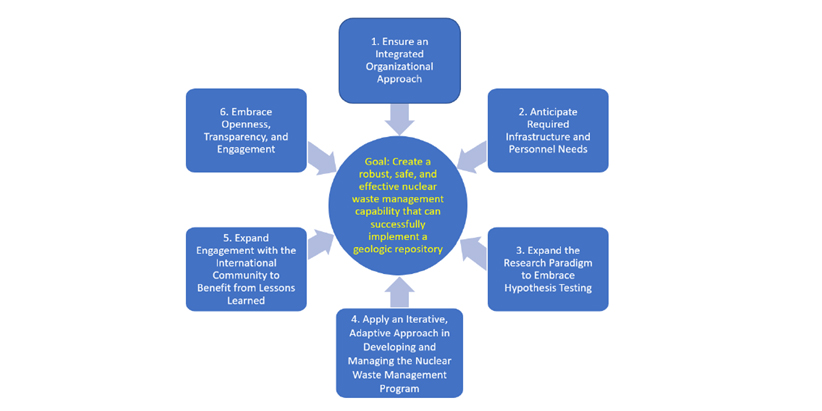The Surry nuclear power plant, near Surry, Va. Photo: Dominion Energy
The Nuclear Regulatory Commission has approved Dominion Energy’s application to renew the Surry nuclear power plant’s operating licenses for an additional 20 years. The renewed licenses authorize the extension of reactor operation at the two-unit plant from 60 to 80 years.
Ray Geimer with DOE contractor Central Plateau Cleanup Company, left, shows company president Scott Sax a mock-up of parts of a vertical pipe casing system at Hanford’s Maintenance and Storage Facility. Photo: DOE
Workers at the Department of Energy’s Hanford Site near Richland, Wash., recently completed testing a mock-up of a system that will be used to isolate and stabilize about 15,000 pounds of radioactive debris in the site’s K West Reactor spent fuel storage basin.
The NWTRB’s six overarching recommendations for the DOE’s nuclear waste management program.
Sandia National Laboratories Photo: SNL
The ANS Young Members Group will focus on Sandia National Laboratories for the latest installment of its webinar series, Spotlight on National Labs, on May 11 at 10:30 a.m. CT.
Register now for the free event.
The B Complex area tank farm at the DOE’s Hanford Site in Washington. Photo: DOE
The Department of Energy announced that it has determined that an underground single-shell waste tank at its Hanford Site near Richland, Wash., is likely leaking into the soil beneath the tank. The DOE said that the leaking tank poses no increased health or safety risk to the Hanford workforce or the public.
Vogtle-3 turbine generator. Photo: Georgia Power
Southern Company is targeting December for placing Vogtle-3 in service, according to Tom Fanning, the company’s chairman, president, and chief executive officer, who spoke with financial analysts on April 29 in its first-quarter earnings call. “The site work plan now targets fuel load in the third quarter and late December 2021 in-service date for Unit 3,” Fanning said. “Of course, any delays could result in a first-quarter 2022 Unit 3 in-service date.”
In 2020, the DOE announced real progress made in the management of liquid radioactive waste at its sites at Savannah River, Idaho, and Hanford.
Plant startup employees work in the process cell area of the Low-Activity Waste Facility at Hanford’s Waste Treatment and Immobilization Plant.
During the annual National Cleanup Workshop, held virtually in September of last year due to the COVID-19 health crisis, William “Ike” White, senior advisor to the under secretary for science in the Department of Energy’s Office of Environmental Management, said that despite the pandemic, 2020 was an inflection year for the DOE and his office.
SRNS subcontractors Donald Miles and Richard Mooney drill for soil samples as part of a project to immobilize I-129 in the groundwater and soil at the Savannah River Site. Photo: DOE/SRNS
A silver chloride–based cleanup technology is expected to reduce radioactive iodine-129 contamination found in soil and groundwater near the center of the Department of Energy’s Savannah River Site in South Carolina to levels well below regulatory limits. The I-129 was created during the production of plutonium and tritium at the site throughout the Cold War era.
Indian Point-3’s turbine hall and generator. Photo: Entergy
The disturbingly long list of U.S. nuclear plants prematurely closed in recent years will get even longer tonight when the last reactor at the Indian Point Energy Center, Unit 3, powers down for the final time. The shutdown, scheduled for 11 p.m. local time, will mark the end of nearly 60 years of zero-carbon electricity generation at the Buchanan, N.Y., facility.
Two of the state’s six nuclear plants nearly closed in 2016, but legislative action saved them. Now two more are at risk.
If there is one U.S. state you might think would be on top of the nuclear-plant-retirement problem, it’s Illinois: With 11 power reactors, more than any other state, it is number one in nuclear generating capacity. In 2019, 54 percent of its in-state generation came from nuclear power. So why, at this writing in mid-April, does Illinois still face the possibility of losing two of its nuclear plants later this year?









 Peter Lyons, former Nuclear Regulatory Commission commissioner (2005–2009) and assistant secretary of energy for nuclear energy (2011–2015), has passed away.
Peter Lyons, former Nuclear Regulatory Commission commissioner (2005–2009) and assistant secretary of energy for nuclear energy (2011–2015), has passed away.







